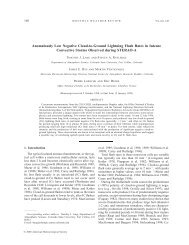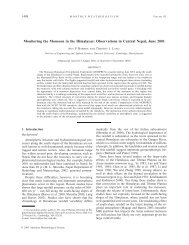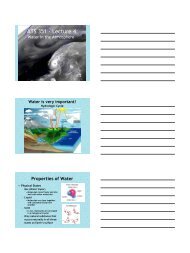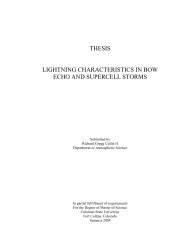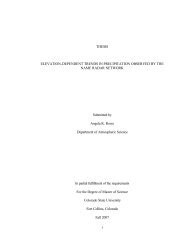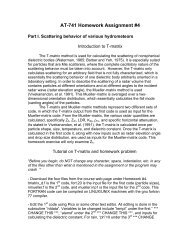1 A dual-polarization radar hydrometeor classification algorithm for ...
1 A dual-polarization radar hydrometeor classification algorithm for ...
1 A dual-polarization radar hydrometeor classification algorithm for ...
You also want an ePaper? Increase the reach of your titles
YUMPU automatically turns print PDFs into web optimized ePapers that Google loves.
535536537538539540541542543544545546547548549550551552553554555556557zero. Nearly equivalent X- and S-band <strong>classification</strong>s of dendrites centered directly on the -15ºClevel were made possible by the &-dependent HCA MBFs. The HCA is able to distinguish snowtypes at S-band despite low K dp magnitudes, which is encouraging since this is the operatingfrequency of the National Weather Service <strong>radar</strong> network. However, the more detailedin<strong>for</strong>mation offered by X-band in this series of simultaneous RHIs is more discriminatory so theX-band HCA seems more robust and precise. The X-band CASA <strong>radar</strong>s also offer enhancedin<strong>for</strong>mation about the location of transition zones between precipitation types, despite its muchcoarser resolution.Areas where Z dr > 1 dB and K dp ~ 0° km -1 toward the tops of these echoes closer to the<strong>radar</strong> may contain pristine crystals that are not being classified clearly because use of highelevation angles may be artificially reducing the measurable K dp and Z dr (see Section 3a, Table4). This is more evident in the X-band RHI because of its 0.3° beam width, which resolves someunorganized plate and dendrite <strong>classification</strong>s near 2.6 km AGL within 40 km range. The<strong>algorithm</strong> also cannot distinguish between small, compact crystals that likely exist above theDGZ in Figures 13 and 14, from the large aggregates of dendrites that surely <strong>for</strong>m below. Thesetwo types of “aggregates,” from a broad meaning of the word, are not distinguishable withpolarimetric <strong>radar</strong> because both have low ! bulk and dielectric factor, despite differences inappearance and shape.6. ConclusionsThe simple fuzzy logic <strong>hydrometeor</strong> <strong>classification</strong> <strong>algorithm</strong> developed herein revealsfive important microphysical processes in winter storms. Ef<strong>for</strong>ts were made to reduce thenumber of categories within each HCA step, which make it easier to modify and use. Withoutusing external temperature in<strong>for</strong>mation, the <strong>algorithm</strong> is able to identify active dendritic and25



